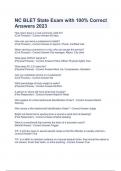Essay
Unit 9 Aim B: Homeostasis and Hormones (DISTINCTION)
- Vak
- Instelling
This is my distinction grade assignment for unit 9 aim B on homeostasis and the regulation of body conditions, including the hormones behind it. All criteria were met and I was awarded distinction. If you have any questions or concerns, please do not hesitate to get in touch. I hope you fin...
[Meer zien]












